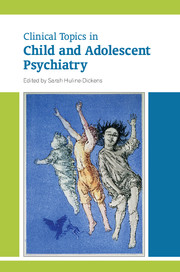Book contents
- Frontmatter
- Contents
- List of tables
- List of boxes
- List of figures
- List of contributors
- Preface
- 1 Child psychiatry and the people who have shaped it
- 2 Fabrication and induction of illness in children
- 3 Personality disorders as disorganisation of attachment and affect regulation
- 4 Post-traumatic stress disorder and attachment: possible links with borderline personality disorder
- 5 Management of antisocial behaviour in childhood
- 6 Pharmacology for attention-deficit hyperactivity disorder, Tourette syndrome and autism spectrum disorder
- 7 Pharmacology for anxiety and obsessive–compulsive disorders, affective disorders and schizophrenia
- 8 Pharmacological management of core and comorbid symptoms in autism spectrum disorder
- 9 Pharmacological treatment of depression and bipolar disorder
- 10 Cognitive–behavioural therapy with children, young people and families: from individual to systemic therapy
- 11 Anxiety disorders
- 12 Somatising: clinical presentations and aetiological factors
- 13 Somatising: management and outcomes
- 14 Evaluating psychological treatments for children with autism
- 15 Attention-deficit hyperactivity disorder: assessment and treatment
- 16 Schizophrenia
- 17 Tourette syndrome
- 18 Sleep disorders
- 19 Self-harm in adolescents
- 20 Adolescent substance misuse: an update on behaviours and treatments
- 21 Eating disorders
- 22 Gender dysphoria in young people
- 23 The psychiatry of children aged 0–4
- Index
12 - Somatising: clinical presentations and aetiological factors
Published online by Cambridge University Press: 02 January 2018
- Frontmatter
- Contents
- List of tables
- List of boxes
- List of figures
- List of contributors
- Preface
- 1 Child psychiatry and the people who have shaped it
- 2 Fabrication and induction of illness in children
- 3 Personality disorders as disorganisation of attachment and affect regulation
- 4 Post-traumatic stress disorder and attachment: possible links with borderline personality disorder
- 5 Management of antisocial behaviour in childhood
- 6 Pharmacology for attention-deficit hyperactivity disorder, Tourette syndrome and autism spectrum disorder
- 7 Pharmacology for anxiety and obsessive–compulsive disorders, affective disorders and schizophrenia
- 8 Pharmacological management of core and comorbid symptoms in autism spectrum disorder
- 9 Pharmacological treatment of depression and bipolar disorder
- 10 Cognitive–behavioural therapy with children, young people and families: from individual to systemic therapy
- 11 Anxiety disorders
- 12 Somatising: clinical presentations and aetiological factors
- 13 Somatising: management and outcomes
- 14 Evaluating psychological treatments for children with autism
- 15 Attention-deficit hyperactivity disorder: assessment and treatment
- 16 Schizophrenia
- 17 Tourette syndrome
- 18 Sleep disorders
- 19 Self-harm in adolescents
- 20 Adolescent substance misuse: an update on behaviours and treatments
- 21 Eating disorders
- 22 Gender dysphoria in young people
- 23 The psychiatry of children aged 0–4
- Index
Summary
Psychological and physical (somatic) symptoms are closely interconnected, and somatisation (Box 12.1) is commonly seen in both primary and secondary care settings. Somatic symptoms are extremely common in children and adolescents, a population who often find it difficult to express their feelings and emotions through language. It is understood that 2–10% of children in the general population complain of bodily aches and pains (stomach aches, joint pains and headaches) that are likely to be medically unexplained (Garralda, 2005). Sometimes, these symptoms lead to significant distress, impairment in functioning and healthcare-seeking behaviour. Somatising disorders can have a significant impact not only on the children themselves but also on their families and healthcare resources. If somatising continues into adulthood it can lead to wide-ranging distress and impairment.
Developmental factors have an important influence on the presentation of disorders. One such factor is that children and adolescents are dependants, largely reliant on adults for significant aspects of ‘illness behaviour’ (Mechanic, 1962). Illness behaviour includes the way in which symptoms are responded to, and the extent to which medical consultation and lifestyle alterations are undertaken. Parents and carers have a powerful impact when they respond to (or ignore) children's physical complaints, attribute significance to (or give reassurance about) these complaints, facilitate (or otherwise) the children's use of healthcare facilities and involve them in (or withdraw them from) normal life activities.
Box 12.1 Definitions
Medically unexplained symptoms All bothersome or recurrent bodily symptoms that are not due to a recognised medical illness.
Somatisation A constellation of clinical and behavioural features indicating that a person is experiencing and communicating psychological distress through physical symptoms not accounted for by pathological findings; the person attributes these symptoms to a physical illness and seeks medical help. The production of symptoms is usually not under conscious control, although in children and adolescents it is particularly difficult to establish the level of conscious control.
Other developmental factors, especially the level of cognitive and verbal competence, have long been recognised as important determinants of the ability to express emotional distress directly by speech. In young children, a variety of primitive and regressive behaviours are commonly recognised as signalling emotional discomfort of various kinds.
- Type
- Chapter
- Information
- Clinical Topics in Child and Adolescent Psychiatry , pp. 183 - 200Publisher: Royal College of PsychiatristsPrint publication year: 2014

